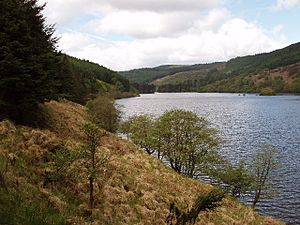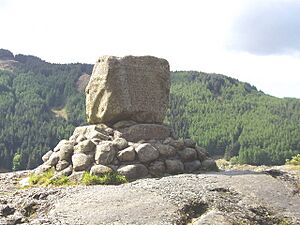Battle of Glen Trool facts for kids
Quick facts for kids Battle of Glen Trool |
|||||||
|---|---|---|---|---|---|---|---|
| Part of First War of Scottish Independence | |||||||
|
|||||||
| Belligerents | |||||||
| Kingdom of Scotland | Kingdom of England | ||||||
| Commanders and leaders | |||||||
| Robert the Bruce | Earl of Pembroke | ||||||
| Strength | |||||||
| Several hundred infantry | Several hundred cavalry | ||||||
| Casualties and losses | |||||||
| Light | Heavy | ||||||
The Battle of Glen Trool was a small but important fight during the First War of Scottish Independence. It happened in April 1307. Glen Trool is a narrow valley in the Southern Uplands of Galloway, Scotland. Loch Trool is a lake in this valley. It runs from east to west and has steep hills on both sides. This made it a perfect spot for a surprise attack. Today, experts are studying this battlefield to protect it.
Robert Bruce had become King of Scots in 1306. This happened after a serious conflict with John "the Red" Comyn, a powerful rival. Robert the Bruce believed he was the rightful king of Scotland. This led to a war between King Robert and King Edward I of England. King Edward I was supported by the Comyn and MacDougall families.
Robert the Bruce's Return
After losing battles at Methven and Dalrigh in the summer of 1306, King Robert was in a tough spot. He had to hide for several months. He seemed to disappear from history for a while. But in the spring of 1307, he returned. He landed in southwest Scotland with new soldiers. Most of these soldiers came from the Macdonald-controlled Isles. This was a smart move because he landed in his own area, Carrick. He knew he would find many supporters there. Also, he knew the countryside well. There were many hidden and difficult areas where his men could find cover and protection.
The English border was close by. All the local castles were strongly held by English forces. The area of Galloway was next to Carrick. It was controlled by the MacDougalls, who were against King Robert. When Robert's brothers, Thomas and Alexander, tried to land near Loch Ryan, they faced disaster. Dungal MacDouall, a strong supporter of the House of Balliol, defeated them.
The Battle at Glen Trool
King Robert managed to set up a strong base in the area. But he needed to win against the enemy. This would help him get more support. He had an early success by raiding an English camp. This camp was on the eastern side of Clatteringshaws Loch. This raid also told the enemy that he was back. Aymer de Valence, who had fought King Robert before, learned where Robert was hiding. He heard that Robert's men were at the head of Glen Trool.
This was a hard place to attack. The lake takes up most of the valley. There is only a narrow path next to a steep slope. In the middle, the hill sticks out sharply. Valence sent a group of soldiers ahead. He hoped to surprise King Robert, just like at Methven. But this time, King Robert used the land to his advantage. He sent some of his men up the steep slope. They had orders to loosen large rocks with tools.
As the English soldiers came up the narrow path, they had to walk in a single line. Locals called this path the "Steps of Trool." King Robert watched them from across the lake. At a signal, his men pushed the wall of boulders down the slope. Then, they shot arrows and charged down the slope. The narrow path meant the English soldiers could not help each other. Many were killed, and the rest had to retreat. King Robert not only survived but won another big battle the next month. This was against the same Earl of Pembroke at the Battle of Loudoun Hill.
The English soldiers who died at Glen Trool were buried. Their burial place is a flat area at the head of the lake. It is known as Soldier's Holm.
King Robert and his 300 men defeated the Earl of Pembroke's 1500 cavalry. This was a major victory for King Robert. It greatly boosted the spirits of his men. The Earl of Pembroke tried again at Loudoun in May 1307. He was soundly defeated once more. This showed that Bruce had learned to change and adapt. He used his knowledge of the land. He also used his knight training and tactics like those of William Wallace. These included ambushes, surprise attacks, and knowing when to advance or retreat.
Remembering the Victory
Bruce's Stone is a large granite rock. It remembers King Robert's victory in 1307. It sits on top of the hill on the north side of Loch Trool. In 1929, on the 600th anniversary of Bruce's death, it was placed there. Legend says King Robert commanded the ambush from this spot. The ambush happened on the Steps of Trool, on the other side of the lake. The stone also marks the start of a challenging walk up Merrick. Merrick is the highest mountain in southern Scotland, standing at 2764 feet.



